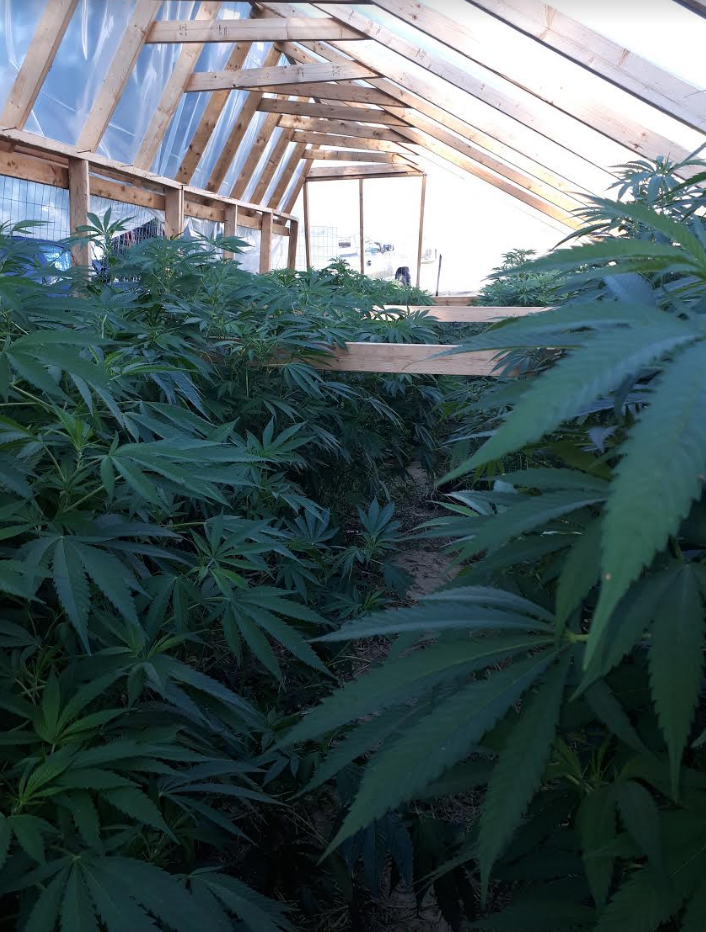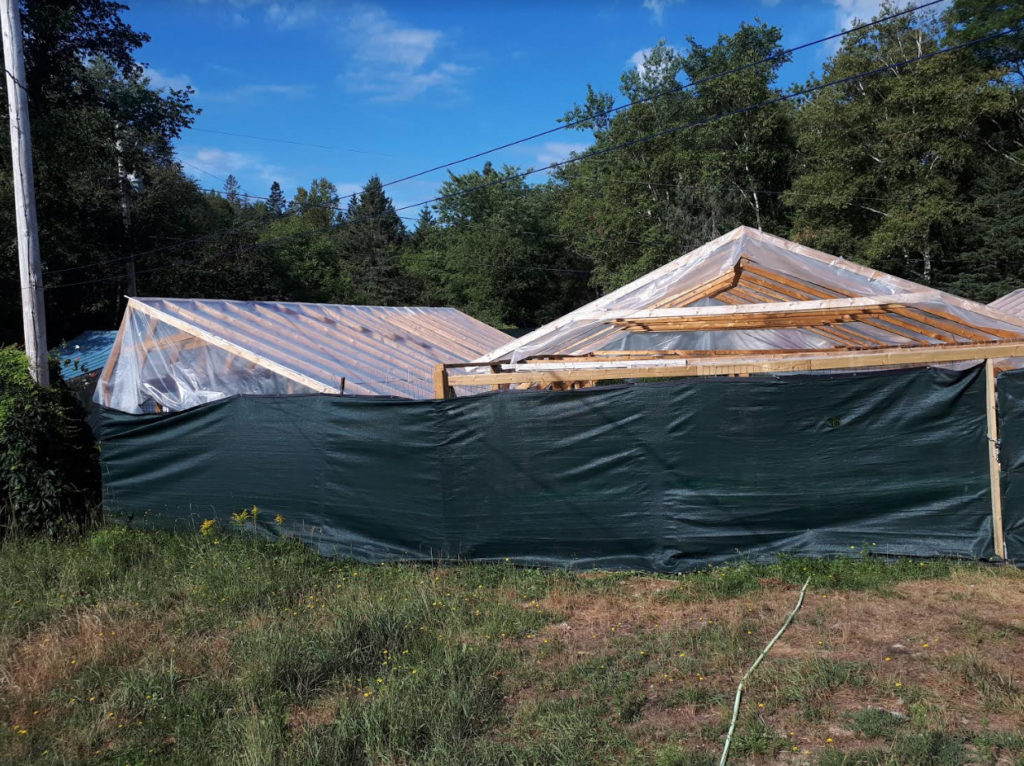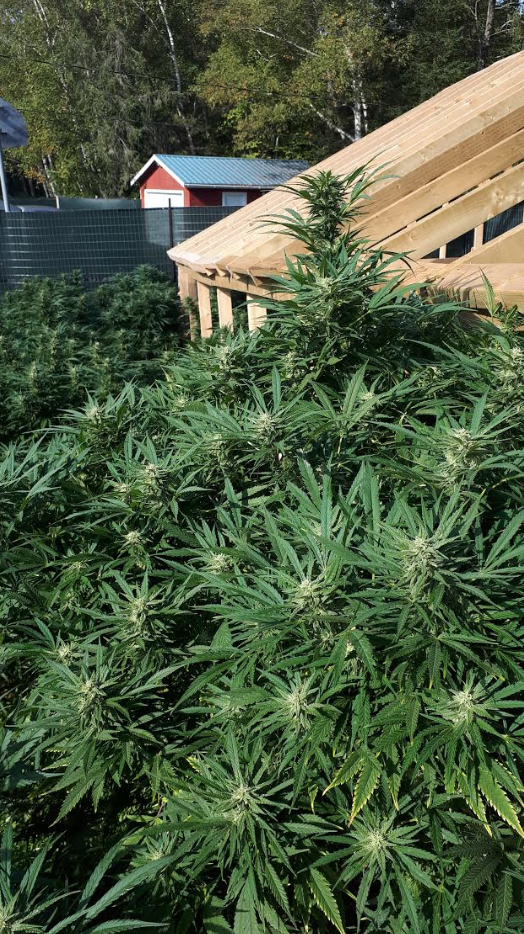
| COMPANY: | SunLeaf Farmacy |
| LICENCE TYPE: | micro cultivation |
| APPROACH: | Outdoor |
| TIMELINE: | ~9 months (December 2018 – September 2019) |
| COST: | $15,000 |
| FACILITY: |
SunLeaf Farmacy is a micro cultivation licence holder in New Brunswick, licensed in September 2019, run by Tamara Follett who has made a name for herself with her micro cultivation Facebook group and providing SOP’s to at least 15 new licences holders to date.
Through her online networking, Follett has created a community of applicants and licence holders working together to navigate the federal licensing process. She also has a video online explaining the process of building out her own site, for around `$15,000.
When was it that you first started looking at applying for a micro cultivation licence?
April 2017 – I considered a standard licence first, but decided it was too much. I decided to wait on the micro legislation passing.
When did you first apply?
December 25, 2018, (I have no life). I was delayed that long because the SOPs I had written for my micro needed to be completely rewritten to match the more rigorous standards that came into effect. I had developed my SOPs based on an anticipated “brewery model” of regulations; HC implemented a pharmaceutical model of regulations.
What were some of the biggest challenges in terms of getting to the point of having a licence?
Without a doubt, for many of us, it was having to navigate HC’s interpretation of the regulations, which varied over time, and from person to person within the organization. I formed the Facebook micro community, Canadian Cannabis Microcultivation, because there were so many unanswered questions and we were all in the same boat. Nobody knew what HC’s interpretations were going to be, and we had no previously licensed micros to learn from. For instance, what constituted an “acceptable” perimeter barrier? -Is anything besides chain link acceptable? Were windows allowed? Was a wood building going to pass or did it need to be brick, cement, or metal? Was unfinished wood in a greenhouse allowed? What EXACTLY does “GPP-compliant” entail? We have solid responses from HC now, and enough people have been licensed (and enough precedents set) that we know the answers to these questions. (Answers are available for everyone to see on the Facebook group, by searching for keywords like “barrier”, “windows”, “plywood”, and so forth.) But back then, we were in shark-infested murky waters with no one to help us out but ourselves. It was sink or swim.
Tell us more about your background in quality assurance and how you came about building the SOP’s so many are using?
I retired at 43 as an internationally-recognized author and subject matter expert in cGxP Pharmaceutical Regulatory Compliance. As a sought-after consultant, I was flown in to resolve noncompliances when a pharma giant had to shut down manufacturing or packaging lines due to a FDA-438 or Consent Decree. In some instances, companies were losing a million dollars a day by shutting a line down. It was very high pressure, but every system I ever remediated passed all further FDA audits. As a consultant, I have audited hundreds of pharmaceutical dispensing, manufacturing, packaging, warehousing, clinical, and laboratory processes, as well as hundreds of vendors who wanted to do business with these industry giants. I’ve seen and worked with just about every process one can come across in pharma manufacturing, from robotic warehouses to transdermal patch packaging lines, from encapsulation machines to vision quality control systems. As a retiree, it was a natural fit to move into another highly regulated industry such as cannabis, and work for myself.
Were you able to bring in genetics through the section 10 allowance? How many?
Yes, just a few that I was working with at the time. My expertise is in regulatory compliance – I am a newbie grower, with only 8 years experience. I planned on getting my genetics from the newly-licensed legacy master growers, and that’s worked very well for me.
Were you able to sell your first crop from last year? What was that process like?
No. I failed microbial testing and so I still have the crop. I applied for my microprocessing licence and am in Final Review, now. I intend to decarb, mill, package, and market last year’s crop under my new trade mark: “Make Anything An Edible” (see www.MakeAnythingAnEdible.ca).
What was the total cost of getting your site compliant and able to receive your initial cultivation licence?
It came in a just under $15,000 but I owned fenced land with a standalone building (a garage) on it. Once licensed there was another big outlay of cash – $2,500 for the yearly licensing fee, and $5,000 for the CRA Bond – but somehow, they didn’t hurt as much as that first $15K, when I didn’t know if I was even going to get licensed…
For someone looking to get a similar outdoor micro cultivation licence, what tips would you give them?
You don’t need a consultant and you don’t have to spend a fortune and get into overwhelming debt. Some folks on my CCM group have retrofitted shipping containers and retired tractor trailer reefers to serve as their GPP-compliant building, and they have been licensed. Join the group and search for “submit” – you’ll get to see the full range of buildings that micros are using, from state-of-the-art to beer-budget. You can also learn exactly what “GPP-compliant” allows and doesn’t allow, by doing searches on that term.
If someone wanted to purchase your SOPs, how would they go about that?
I have a website where people can learn more about what I offer: www.SunLeafMicrocultivation.ca
You mentioned an anticipated “brewery model” of regulations. Can you provide more details on this? Who was this model anticipated by and what were the proposed brewery model regulations?
Before any proposed regulations had come out, I made my best-guess on what they would look like, and wrote SOPs to adhere to that anticipated model. I used craft breweries as a model (as opposed to a food manufacturing model or an herbal supplements model) based on the similarities between craft brewers and craft cannabis growers: both were highly regulated; both needed to be kept away from children; both were consumables; both were potentially dangerous; both needed to be carefully controlled during manufacturing; both needed limits on potency; both could be over-imbibed and cause health risks. Finally, I considered risk mitigation, and there were decades of anecdotal evidence on the relative safety of cannabis versus alcohol. The similarities were so many, and the risks even less than alcohol, that I felt sure HC would choose the small craft brewery model to fashion the small craft cannabis regulations after. I was very wrong. HC used the pharmaceutical drug model as a basis for the cannabis regulations. This came as a grinding shock; while it makes sense for medical cannabis, it was serious overkill for recreational. It was while I was retrofitting my SOPs from the brewery model to a pharmaceutical model that I realized how impossible of an ask this was for most legacy growers. How many legacy growers even knew what Standard Operating Procedures were or why they mattered? How many had ever worked in a regulated industry? Not very many. This depressed me greatly. On paper, Canada looked so progressive, allowing in the small craft growers… But in reality, there were insurmountable obstacles placed in their way. It took me 5 months to write those SOPs, and I can write SOPs in my sleep. How long would it have taken most micros to write 500 pages of procedures from a blank page? How sturdy of a “safety net” would they be able to construct for themselves? So I decided to help. Once I had decided to make a DIY SOP Kit available to other craft growers, the question became one of price. My time was billed at $250/hour when I retired, and it had taken months to write these procedures… no craft grower could possibly afford what they were really worth. So I decided to “pay it forward” and offer them at a price any small mom and pop grower could afford: $2,500, HST included. That price remains the same. Many don’t realize what a gift this is, but I didn’t do it for the accolades – I did it to level the playing field and allow legacy growers a real chance to take their place on the global stage.
What regulatory changes would you like to see for micro cultivators and processors?
I want to see farmgate put into place, but the unreasonable requirements HC has in place for the Quality Assurance Person (QAP) that microprocessors are required to have is an effective blockade to small player market entry. For instance while there are 62 licenced microcultivators to date, there are only 15 microprocessors licenced in almost 2 years. This is because HC sets an extremely high bar for micros to be able to do something as simple as package their flower and sell it themselves. For example, when I recently submitted my microprocessing application, HC asked for specific instances and dates wherein I had experience with “validation of testing methods”, equipment such as “conveyances”, and “effectiveness studies”. Now, I am applying to mill, decarb, and hand-fill pouches with my flower, so why on earth do I need to know how to “validate testing methods”, work with packaging lines, or document a clinical trial (i.e., “effectiveness study”)? It’s SO blatantly absurd to ask for all these qualifications that it’s tantamount to requiring an Einstein to teach Science Class.
These are the roadblocks faced by any legacy processor that wants to transition from the black market and make legal extracts or edibles. It’s clearly almost impossible, as evidenced by the few microprocessors licensed so far. I told HC point-blank that this wish list of requirements is egregiously excessive, that it suggests a purpose-built obstacle to prevent market entry for small growers, and that the credentials of the QAP should be tied directly to the tasks they will be required to perform. How many skills does it really take to put flower in a bag and put a label on it? For dried flower, the most minimal QAP requirements should be in place; for topicals, slightly higher qualifications, for edibles and extracts, reasonably higher, and for distillates, the most credentials. To ask for such extensive qualifications from the lowliest QAP means we will never see farm-to-gate sales as a reality. HC has “unbent” on some of their interpretations of the regulations (vaults and 2-test-crops are no longer necessary), but on this unjustifiable position they remain resolute. I have hope that will change with concerted pressure from the micro community.















